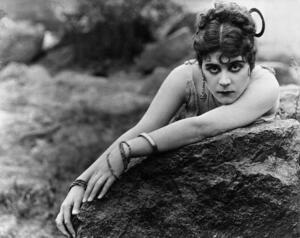"New York Times" profile of silent film star, Theda Bara
Born Theodosia Goodman on July 29, 1890, Theda Bara had a brief but notable career as the star of dozens of silent films. Raised in Cincinnati, Bara moved to New York City at age 18 to pursue an acting career. Only marginally successful on the stage, she became an overnight sensation when director Frank Powell cast her as the star of A Fool There Was in 1915. In the film, which was based on a stage melodrama that was in turn based on a Rudyard Kipling poem, Bara played a temptress who squeezed money, dignity, and finally life out of men. As the sensuous, cruel seductress, Bara created the original "vamp."
Over the next five years, Bara starred in 40 films, almost always as a "vamp," an exotic woman luring men to ruin. Her films were considered scandalous, and at least one critic advocated censoring them. However, Bara was wildly popular with the public, who flocked to her films. A profile of Bara that appeared in the New York Times on February 20, 1916, reported that 500,000 fans followed Bara everywhere she went. She was said to have received over a thousand marriage proposals from adoring fans. Others named children after her. One critic called her "a clever actress with ... a marvelously mobile and expressive face."
Despite Bara's popularity, the Fox studio refused to renew her contract after 1919. The film industry had moved on to a cleaner image of sexuality. Seductresses would abound in later Hollywood films, but without the aura of mystery and menace that had defined Bara's roles. After 1920, Bara starred in only two more films, in 1925 and 1926. Although the 1916 profile predicted that Bara would eventually move to the stage, where she would succeed as "a skillful tragedienne," her acting career ended when film roles disappeared. She died on April 7, 1955. Today, the only surviving Bara film is A Fool There Was, her first success.
To learn more about Theda Bara, visit Jewish Women: A Comprehensive Encyclopedia.
Sources:Jewish Women in America: An Historical Encyclopedia, pp. 118-120; New York Times, January 24, 1916, February 20, 1916.




She certainly was one the 'Iconic' figures of early Hollywood. Her early publicity, which was, an entire fabrication on the part of her studio: which gave her back ground as an Egyptian born daughter ; of a French actress and an Italian sculptor, of noble lineage. It was also responsible for the origin of her name being derived from an anagram of : "Arab Death." Later the Goodman family, legally changed their name to Bara. It is a great pity that her films' were destroyed during a fire in the 1930's. Apart from 'A fool there was' there remain only a few seconds' of film from some of her others.' It is worth noting that her: sensual and cruel portrayals, were not cut back because of the ; Hayes, Morality Code----that came in the 30s, but because, she: really pushed boundary's. A true original.